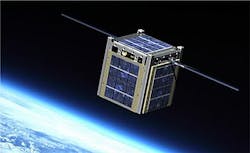ARLINGTON, Va., 2 Dec. 2012. Reconnaissance and surveillance experts at the Raytheon Co. Missile Systems segment in Tucson, Ariz., are helping a U.S. military effort to provide useful persistent-surveillance imagery on-demand to the lowest-echelon warfighter in the field from small low-cost satellites.
Raytheon received a $949,679 contract Tuesday from the U.S. Defense Advanced Research Projects Agency (DARPA) in Arlington, Va., for the Space Enabled Effects for Military Engagements (SeeMe) program.
SeeMe will develop enabling technologies that eventually could help make relevant battlefield imagery available to front-line warfighters in real time using constellations of temporary and inexpensive orbiting satellites that are launched quickly enough to support fast-moving military operations.
The SeeMe satellites would fill gaps in battlefield situational awareness before, during, and after military engagements, DARPA officials say.
The SeeMe program would provide reliable persistent-surveillance data to front-line forces using small, short-lived, very-low-cost satellites operating at low altitudes that are networked to fielded military communications systems and handheld devices.
For the SeeMe program, Raytheon engineers will try to find ways to build satellites that cost no more than $500,000 each, not counting launch and ground-support operations. Other contractors in addition to Raytheon most likely will become involved in the SeeMe program.
Ultimately, small satellites developed with SeeMe program technology should receive support from the DARPA Airborne Launch Assist Space Access (ALASA) program, which is trying to develop the ability to launch a 100-pound satellite for a total cost of less than $1 million, which is about one-third of today's satellite launch costs.
DARPA awarded five ALASA research contracts earlier this year to Space Information Laboratories LLC in Santa Maria, Calif.; Ventions LLC in San Francisco; the Boeing Co. in Huntington Beach, Calif.; Northrop Grumman Corp. in El Segundo, Calif.; and Lockheed Martin Corp. in Palmdale, Calif.
The SeeMe short-duration satellite constellations would compensate for today's weaknesses in gathering situational-awareness data that today does not provide the lowest-echelon warfighters with on-demand satellite imagery due to the unavailability of satellite overflight opportunities, lack of information distribution channels, priority conflicts, and classification restrictions.
At the same time, terrorists and other enemy forces have access to commercial imagery information that gives them an advantage. The SeeMe program would give small U.S. squads and fire-teams reliable information in remote and beyond-line-of-sight conditions, DARPA officials say.
Rather than using expensive high-orbit reconnaissance satellites that are tasked remotely and their products analyzed through a centralized organization, the SeeMe program would use short-lived low-cost satellites would provide large global coverage at lower cost than a set of unmanned aerial vehicles (UAVs) flying simultaneously over several theaters per day, DARPA officials say.
SeeMe satellites would be designed based on cost, rather than on performance, and would seek to revolutionize the existing satellite-development model to cut costs to a fraction of manned or unmanned aircraft -- primarily using commercial off-the-shelf (COTS) components.
SeeMe satellites also would use non-traditional RF and optical apertures and imagery processing techniques, as well as innovative manufacturing and rapid launch systems to match the speed of military operations.
The combined SeeMe and ALASA programs will culminate in an on-orbit demonstration in 2014 or 2015 of a constellation of 24 SeeMe satellites operating in low orbits between 125 and 185 miles above the Earth.
The program seeks to deliver a constellation of small reconnaissance satellites within 90 days order at a cost of about $12 million -- a fraction of the cost of an existing UAV. SeeMe satellites would provide persistent coverage of any point on the Earth with no coverage gaps greater than 90 minutes, and would last for at least 45 days.
The preliminary phase of the SeeMe program is to last for 14 months, while the second phase of the program would last for 15 months and demonstrate a production run of at least six satellites. The third phase would last a year and produce a constellation of 24 satellites.
For more information contact DARPA online at www.darpa.mil.



